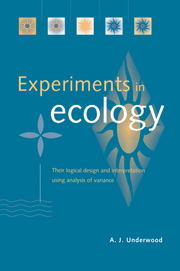Book contents
- Frontmatter
- Contents
- Acknowledgements
- 1 Introduction
- 2 A framework for investigating biological patterns and processes
- 3 Populations, frequency distributions and samples
- 4 Statistical tests of null hypotheses
- 5 Statistical tests on samples
- 6 Simple experiments comparing the means of two populations
- 7 Analysis of variance
- 8 More analysis of variance
- 9 Nested analyses of variance
- 10 Factorial experiments
- 11 Construction of any analysis from general principles
- 12 Some common and some particular experimental designs
- 13 Analyses involving relationships among variables
- 14 Conclusions: where to from here?
- References
- Author index
- Subject index
12 - Some common and some particular experimental designs
Published online by Cambridge University Press: 05 June 2012
- Frontmatter
- Contents
- Acknowledgements
- 1 Introduction
- 2 A framework for investigating biological patterns and processes
- 3 Populations, frequency distributions and samples
- 4 Statistical tests of null hypotheses
- 5 Statistical tests on samples
- 6 Simple experiments comparing the means of two populations
- 7 Analysis of variance
- 8 More analysis of variance
- 9 Nested analyses of variance
- 10 Factorial experiments
- 11 Construction of any analysis from general principles
- 12 Some common and some particular experimental designs
- 13 Analyses involving relationships among variables
- 14 Conclusions: where to from here?
- References
- Author index
- Subject index
Summary
Certain sorts of experimental designs recur repeatedly because, despite the specific models and hypotheses, there are common needs for spatial replication, controls, etc. Some of these designs rejoice in specific names – the taxonomy of which can become quite cumbersome. Several of them derive from their early agricultural roots (Fisher, 1935).
Rather than attempt to understand these designs in the ways they are usually presented in textbooks, it is undoubtedly a much better strategy to learn how to construct an experimental design from first principles, as in Chapter 11. In that way, you are less likely to pick an incorrect design for your experiment. You are also far less likely to be tempted to try to identify an appropriate framework for analysing data after you have done the experiment.
Nevertheless, some designs warrant specific mention in detail – if only to demonstrate some problems in their use. Some of the most commonly used experimental designs cause assumptions to be made about the nature of or relationships among data over and above assumptions about their distributions. These assumptions are often unlikely to be true but, sadly, are often ignored in the way the designs are explained or ignored, to the detriment of interpretations, when data are analysed. Some of the most common designs are considered below.
In addition, some consideration is given to asymmetrical experimental designs that have particular merit in some aspects of experimental ecology and environmental sampling.
- Type
- Chapter
- Information
- Experiments in EcologyTheir Logical Design and Interpretation Using Analysis of Variance, pp. 385 - 418Publisher: Cambridge University PressPrint publication year: 1996



